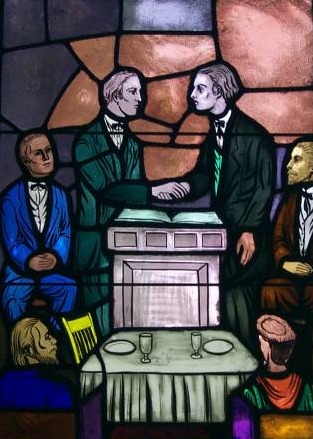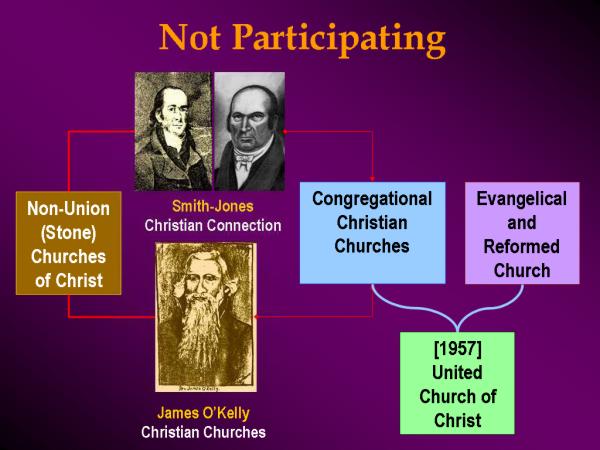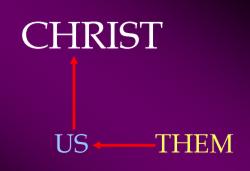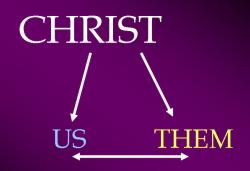1832: THE UNION
Restoration History #6
 Click here to listen to this sermon.
Click here to listen to this sermon.
Please ask Chris Benjamin for permission before reproducing
any of the images, graphics, or charts on this page. |

stained glass at Cane Ridge commemorating the 1832 union of Christians & Disciples
with the handshake of Barton W. Stone and Raccoon John Smith
|
Barton Stone
Christian Churches
Churches of Christ
|
|
Alexander Campbell
Disciples of Christ
|
Much in Common
- Scripture is the only true authority
- Ending division among followers of Christ
- The church depicted in the New Testament was the ideal church, pure and free from all the corruption of the ages
- Restoring that unified church was important.
"Why Arent We One?"
- Stone was willing to unite
- Christian Messenger - Stone gave two reasons for Campbellite reluctance:
- Fellowship with the un-immersed among Christian churches
- Use of the name Disciples
Much in Contrast
- Campbell was too rigid on certain doctrines.
- Goal of reform was to return to the ancient gospel and order of things.
- Restoring NT church order would reform the church and bring Christian unity.
|
|
- Stone was too lax on doctrine.
- Goal of reform was to create lives characterized by the spirit of Christ.
- Christian freedom would yield virtues and then unity.
|
Christology and Trinity
- Stone opposed traditional understandings.
- Jesus was Son of God and Savior; the Father exalted.
- Christ was not equal to the Father.
|
|
- Campbell held traditional view of the godhead - one deity, yet three persons.
- Christ had to be equal to God or He could not save us.
|
Holy Spirit
- Stone believed the Holy Spirit freely operated in paranormal ways.
- Spiritual manifestations and miracles were possible.
- Stone promoted revivals.
|
|
- Campbell taught the Spirit operated through the inspiration of the Word to convert sinners.
- Rejected emotional displays without denying indwelling.
- Campbell preferred rational teaching to revivals.
|
Human Nature
- Stone was pessimistic.
- Holy Spirit was necessary to convict and convert the sinner.
- Human society would decline.
- Premillennial.
|
|
- Campbell was optimistic.
- Human reason was sufficient to respond to the gospel.
- America was part of Gods plan to bring about a Christian world.
- Postmillennial.
|
Baptism, Communion, Clergy
- Unimmersed could be members in Stone churches.
- Communion service was sporadic.
- Ordained elders and recognized official clergy.
|
|
- Immersion was part of membership in Campbell churches.
- Communion was weekly.
- Democratic about leadership and anti-clerical.
|
Practical Barriers
- Despite these differences, unity was desired.
- Practical barriers to the unity included:
- No central offices to make a union.
- The only governing authority was each local congregation.
- The union had to happen in each city, town or village throughout the country.
Raccoon John Smith
- Born in Sullivan Co., Tennessee, Oct. 15, 1784.
- Died in Mexico, Missouri, Feb. 28, 1868.
- Raised in Stockton Valley, Kentucky.
- Strict Baptist upbringing - entered into ministry.
- Rejected Calvinist doctrine after death of children.
- Interested in Campbells Christian Baptist and the Restoration effort.
Efforts at Union
- Conference in Lexington, KY to discuss union [1831-1832]
- Many favored slow, gradual union
- Smith and Stone were the final speakers
- Smith preached that the differences were not part of the gospel
Smiths Proposal
- Inferences are not barriers.
- Love one another.
Let us then, my brethren, be no longer Campbellites or Stonites, New Lights or Old Lights, or any other kind of lights. But let us come to the Bible and the Bible alone, as the only book in creation that can give us all the Light we need.
The Union
- Stone had no objection.
- Shared communion on Sunday, January 1, 1832.
- Raccoon Smith and John Rogers were commissioned to tell the churches in order to increase and consolidate the union.
- Campbell acknowledged the Lexington meeting in the Millennial Harbinger.
Unity is Hard Work
- Worship styles
- Stonite churches = emotional and expressive
- Campbellite churches = rational and reserved
- The work of the Holy Spirit
- The name of the church
Some Objected to the Union

How Was Union Possible?
- They believed union was Gods will.
- They focused on what was most important.
- They loved one another as Gods children.
- Put up with peculiarities.
- Christian unity may not always mean a merger.
It Is Possible
No one who does a miracle in my name can in the next moment say anything bad about me, for whoever is not against us is for us.
- Mark 9:39-40


Chris Benjamin
West-Ark Church of Christ, Fort Smith, AR
Evening Sermon, 13 April 2008
 Link to next sermon
Link to next sermon
 Link to other sermons of Chris Benjamin
Link to other sermons of Chris Benjamin




 Link to next sermon
Link to next sermon
 Link to other sermons of Chris Benjamin
Link to other sermons of Chris Benjamin